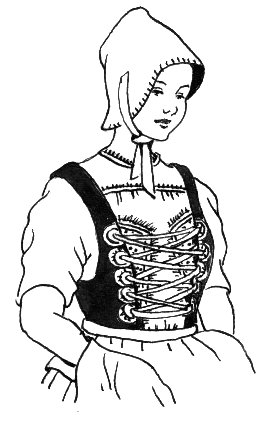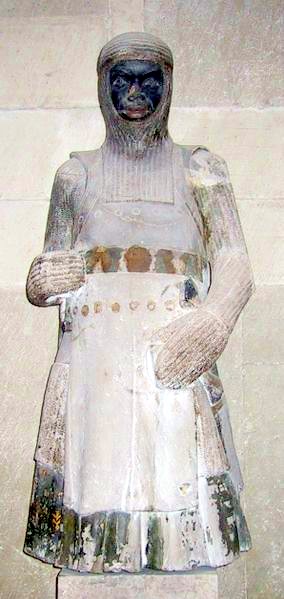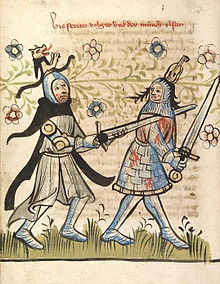History
Men's surcoat
From about the late 12th century, knights wore long, flowing surcoats. From the early to mid 13th century, these were frequently emblazoned with their personal arms, over their armour. These usually extended to about mid-calf, had slits in the bottom front and back, allowing the wearer to ride comfortably, and were either sleeved or sleeveless. Some historians believe that the practice of wearing white surcoats was adopted during the Crusades, their main purpose being to reflect the direct sun, which overheated the armour (and the soldier inside) – although it may be argued that here its color would have been of little help, while in poor weather they helped keep rain and the muck of battle away from the easily corroded mail links. The surcoat displayed the device of the knight (origin of the term "coat of arms"), thereby identifying him, which in turn, combined with the increased use of the great helm (late 12th century, early 13th century), became an essential means of recognition. Indeed, some historians cite this as one of the reasons behind the spread of heraldry across medieval Europe. In the early fourteenth century, the front of the knight's surcoat was shortened so that it was longer at the back and knee-length at the front, allowing greater freedom of movement and eliminating the danger of a rider getting his spurs caught in the garment. By the mid-fourteenth century, it was replaced with the "jupon" (or "gipon"), a much shorter item, often padded for supplementary protection. [2]
In the 15th century, once suits of plate armour became common, the surcoat was phased out of use. This period in the history of armour development, in which surcoats became increasingly rare, is referred to as the "surcoatless period" (1420–1485).
Women's surcoat
Women began wearing surcoats during the 13th century, both with and without sleeves. [3] A particular style, known as the sideless surcoat, developed as a fashion in the 14th century. This was a sleeveless, floor-length garment featuring exaggerated armholes, which at their most extreme were open from shoulder to hip, revealing the gown underneath. The narrow strip covering the torso, known as the plackard, [4] was usually no more than a foot wide. The style drew criticism from some moralists, who thought the garment drew an inappropriate amount of attention to the female body. [3] Despite this, sideless surcoats continued to be worn as ceremonial dress well into the 15th century, long after they had ceased to be fashionable. Some estimates place them being worn as state apparel as late as 1525. [4]

An apron is a garment that is worn over other clothing to cover the front of the body. They may have several purposes, typically as a functional accessory that protects clothes and skin from stains and marks. However, other types of aprons may be worn as a decoration, for hygienic reasons, as part of a uniform, or as protection from certain dangers such as acid, allergens or excessive heat. It can also be used at work stations to hold extra tools and pieces or protect from dust and unwanted materials.

A tabard is a type of short coat that was commonly worn by men during the late Middle Ages and early modern period in Europe. Generally worn outdoors, the coat was either sleeveless or had short sleeves or shoulder pieces. In its more developed form it was open at the sides, and it could be worn with or without a belt. Though most were ordinary garments, often work clothes, tabards might be emblazoned on the front and back with a coat of arms (livery), and in this form they survive as the distinctive garment of officers of arms.

A sweater or pullover, also called a jersey or jumper, is a piece of clothing, typically with long sleeves, made of knitted or crocheted material that covers the upper part of the body. When sleeveless, the garment is often called a slipover, tank top, or sweater vest.

A cuirass is a piece of armour that covers the torso, formed of one or more pieces of metal or other rigid material. The word probably originates from the original material, leather, from the French cuirace and Latin word coriacea. The use of the term "cuirass" generally refers to both the breastplate and the backplate pieces; whereas a breastplate only protects the front, a cuirass protects both the front and the back of the wearer.

A shirt is a cloth garment for the upper body.

A coat is typically an outer garment for the upper body, worn by any gender for warmth or fashion. Coats typically have long sleeves and are open down the front, and closing by means of buttons, zippers, hook-and-loop fasteners, toggles, a belt, or a combination of some of these. Other possible features include collars, shoulder straps, and hoods.

A bodice is an article of clothing traditionally for women and girls, covering the torso from the neck to the waist. The term typically refers to a specific type of upper garment common in Europe during the 16th to the 18th century, or to the upper portion of a modern dress to distinguish it from the skirt and sleeves. The name bodice is etymologically an odd plural spelling of "body" and comes from an older garment called a pair of bodies.

A brigandine is a form of body armour from the late Middle Ages and up to the early Modern Era. It is a garment typically made of heavy cloth, canvas, or leather, lined internally with small oblong steel plates riveted to the fabric, sometimes with a second layer of fabric on the inside.

A doublet is a man's snug-fitting jacket that is shaped and fitted to a man's body. The garment was worn in Spain, and spread to the rest of Western Europe, from the late Middle Ages up to the 17th century. Until the end of the 15th century, the doublet was usually worn under another layer of clothing such as a gown, mantle, or houppelande when in public. In the 16th century it was covered by the jerkin. Women started wearing doublets in the 16th century, and these garments later evolved as the corset and stay. The doublet was thigh length, hip length or waist length and worn over the shirt or drawers.
A dolman is either a military shirt, or a jacket decorated with braiding, first worn by Hungarian hussars. The word is of Turkish origin, and after being adopted into Hungarian, has propagated to other languages. The garment was worn by peasants from the 16th century onward and eventually spread throughout the country, mainly within wealthy peasant circles. It reached people living in the poorest conditions only at the end of the 19th century.

A pelisse was originally a short fur-trimmed jacket which hussar light-cavalry soldiers from the 17th century onwards usually wore hanging loose over the left shoulder, ostensibly to prevent sword cuts. The name also came to refer to a fashionable style of woman's coat-like garment worn in the early-19th century.

The Inverness cape is a form of weatherproof outer-coat. It is notable for being sleeveless, the arms emerging from armscyes beneath a cape.

Fashion in 15th-century Europe was characterized by a series of extremes and extravagances, from the voluminous robes called houppelandes with their sweeping floor-length sleeves to the revealing doublets and hose of Renaissance Italy. Hats, hoods, and other headdresses assumed increasing importance, and were draped, jeweled, and feathered.

Fashion in fourteenth-century Europe was marked by the beginning of a period of experimentation with different forms of clothing. Costume historian James Laver suggests that the mid-14th century marks the emergence of recognizable "fashion" in clothing, in which Fernand Braudel concurs. The draped garments and straight seams of previous centuries were replaced by curved seams and the beginnings of tailoring, which allowed clothing to more closely fit the human form. Also, the use of lacing and buttons allowed a more snug fit to clothing.

The European buff coat is an item of leather clothing that was primarily worn by cavalry and officers during the 17th century, but also worn by a small number of infantry. It was often worn under iron or steel armour for the torso. The buff coat was derived from the simple leather jerkins employed by huntsmen and soldiers during the Tudor period, these in turn deriving from the arming doublet. The name of the jacket, as well as its characteristic tan or buff colour, derives from the buffalo or ox hide from which it was commonly made.

A coat of plates is a form of segmented torso armour consisting of overlapping metal plates riveted inside a cloth or leather garment. The coat of plates is considered part of the era of transitional armour and was normally worn as part of a full knightly harness. The coat saw its introduction in Europe among the warring elite in the 1180s or 1220s and was well established by the 1250s. It was in very common usage by the 1290s. By the 1350s it was universal among infantry militias as well. After about 1340, the plates covering the chest were combined to form an early breastplate, replacing the coat of plates. After 1370, the breastplate covered the entire torso. Different forms of the coat of plates, known as the brigandine and jack of plates, remained in use until the late 16th century.

Costume during the thirteenth century in Europe was relatively simple in its shapes, rich in colour for both men and women, and quite uniform across the Roman Catholic world as the Gothic style started its spread all over Europe in dress, architecture, and other arts.

Twelfth century European fashion was simple in cut and differed only in details from the clothing of the preceding centuries, starting to become tighter and more similar for men and women as the century went on, which would continue in the 13th century. Men wore knee-length tunics for most activities, and men of the upper classes wore long tunics, with hose and mantle or cloaks. Women wore long tunics or gowns. A close fit to the body, full skirts, and long flaring sleeves were characteristic of upper-class fashion for both men and women.
The Medieval period in England is usually classified as the time between the fall of the Roman Empire to the beginning of the Renaissance, roughly the years AD 410–1485. For various peoples living in England, the Anglo-Saxons, Anglo-Danes, Normans and Britons, clothing in the medieval era differed widely for men and women as well as for different classes in the social hierarchy. The general styles of Early medieval European dress were shared in England. In the later part of the period, men's clothing changed much more rapidly than women's styles. Clothes were very expensive and both the men and women of lower social classes continued also divided social classes by regulating the colors and styles these various ranks were permitted to wear. In the early Middle Ages, clothing was typically simple and, particularly in the case of lower-class peoples, served only basic utilitarian functions such as modesty and protection from the elements. As time went on the advent of more advanced textile techniques and increased international relations, clothing gradually got more and more intricate and elegant, even with those under the wealthy classes, up into the renaissance.

An overskirt is a type of women's short skirt which is draped over another garment, such as a skirt, breeches, or trousers. Although peplum is often used as another term for overskirt, it should not be confused with the peplos or "peplum dress", which was worn in ancient Greece.

























